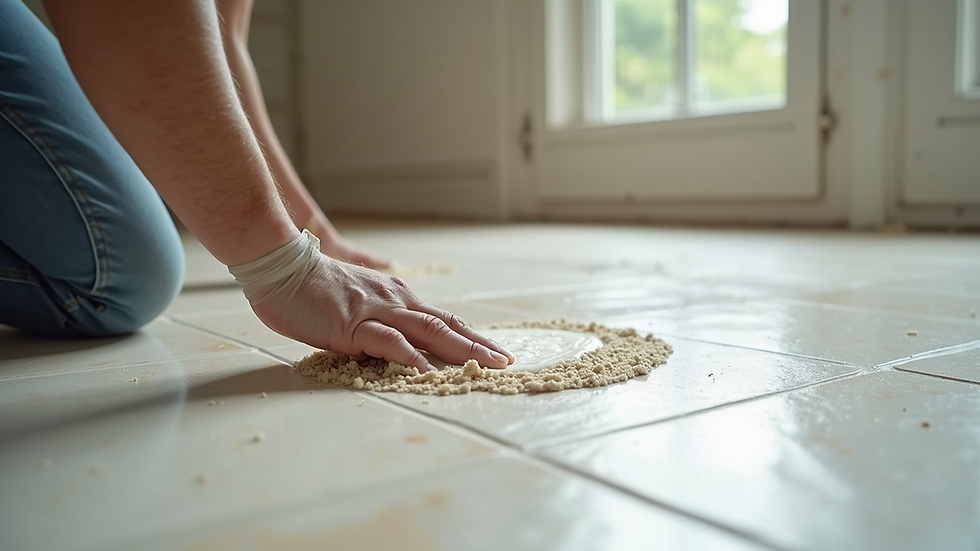The Ultimate Guide to Choosing the Right Bathroom Tiles
- Dhimiter Rrera

- May 7
- 4 min read
Updated: May 29
When creating a beautiful and functional bathroom, selecting the right tiles is crucial. Bathroom tiles not only enhance the aesthetic appeal but also contribute to the room's durability, safety, and hygiene. With countless options in color, material, size, and finish, choosing the perfect tiles can feel overwhelming—particularly if you're doing it for the first time.
This beginner’s guide covers everything you need to know about choosing bathroom tiles, including expert tips, tile types, and layout ideas.
Why Are Bathroom Tiles So Important?
Tiles play a significant role in bathroom functionality. They serve as a practical solution to moisture issues, prevent mold growth, and ensure long-lasting durability. Properly selected bathroom tiles can:
Resist water and humidity
Provide grip to prevent slips
Make small bathrooms appear larger
Create a luxurious, spa-like atmosphere
Whether you’re tiling a bathroom from scratch or remodeling an old one, this guide helps you make confident tile choices.
Types of Bathroom Tiles to Consider
Understanding the types of tiles available is essential as the first step in your tile selection. Here are the most common options:
Ceramic Tiles
Durable and cost-effective
Ideal for walls and floors
Available in various styles and patterns
Porcelain Tiles
Denser and more water-resistant than ceramic
Perfect for floors and wet zones
Slightly pricier but long-lasting
Glass Tiles
Reflective and modern
Excellent for accent walls or borders
Easy to clean but may be slippery
Natural Stone Tiles
Includes marble, granite, slate, and travertine
Adds luxury and texture
Requires sealing and regular maintenance
Standard Bathroom Tile Sizes
Before selecting bathroom tile sizes, consider the room’s layout and tile placement:
Floor Tiles: 300x300 mm or 600x600 mm
Wall Tiles: 300x600 mm or 250x400 mm
Mosaic Tiles: Typically 25x25 mm for accents
Large Format Tiles: 600x1200 mm for a seamless look
Knowing standard bathroom tile sizes helps you visualize your layout better and minimize grout lines, thereby enhancing the visual appeal.
Design Tips for Picking Bathroom Tile
Choose a Focal Point
Select one area of the bathroom, such as the shower wall or vanity backsplash, to emphasize with patterned or textured tiles.
Keep It Balanced
If you choose bold floor tiles, opt for subtle wall tiles, or vice versa, to create harmony.
Stick to a Color Palette
Using neutral colors like whites, greys, and beiges offers a timeless look, while darker tones can add drama and elegance.
Use Grout Strategically
Contrast grout can define each tile, whereas matching grout provides a seamless appearance.
How to Pick Tile for Bathroom – Key Considerations
If you're wondering how to choose bathroom tiles correctly, focus on these essential factors:
Slip Resistance
Look for tiles with anti-skid ratings, especially for the floor. Matte or textured finishes enhance grip.
Water Absorption
Tiles used in wet areas must be highly water-resistant—porcelain is often a safe choice.
Durability
Choose sturdy tiles for floors. Lightweight options like ceramic are excellent for walls.
Ease of Cleaning
Glossy tiles are easier to wipe down, but matte tiles tend to hide water spots and smudges better.
How to Tile a Bathroom – Step-by-Step Basics
Whether you hire a professional or DIY, knowing the tiling process helps you plan better:
Step 1: Plan Your Layout
Accurately measure the space and create a tile layout on paper.
Step 2: Choose Your Adhesive and Grout
Select waterproof adhesives and mold-resistant grout to ensure longevity.
Step 3: Prepare the Surface
Make sure the wall or floor is smooth, dry, and clean before tiling.
Step 4: Lay the Tiles
Start from the center or most visible area, and work your way outwards.
Step 5: Grouting and Sealing
Allow the tiles to set, then fill the gaps with grout and seal if necessary.
This section includes crucial keyword optimization for:
how to tile a bathroom
tiling a bathroom
how to install bathroom tile
how do you lay tile in a bathroom
laying wall tiles in bathroom
steps to tiling a bathroom
Expert Tips for Tiling Your Bathroom Like a Pro
Use spacers to maintain even grout lines.
Dry lay a few tiles before applying adhesive to check alignment.
Always start tiling from the center, not the edges.
In small bathrooms, use large, light-colored tiles to create the illusion of space.
Consider adding a feature strip or mosaic to break the monotony.
FAQs on Selecting and Installing Bathroom Tiles
How do I pick tile for a small bathroom?
Go for large, light-colored tiles with minimal grout lines. They make the room appear bigger and cleaner.
Can I use wall tiles on the floor?
Usually not—floor tiles are thicker and more durable. Check the manufacturer’s rating before use.
What is the easiest bathroom tile to install?
Vinyl or ceramic tiles with peel-and-stick or click systems are beginner-friendly.
Should I tile the bathroom ceiling?
In shower areas, yes. It helps protect from steam and mold. Elsewhere, paint is usually enough.
Final Thoughts: How to Choose Bathroom Tiles the Right Way
Choosing the right bathroom tiles is essential for creating a functional, safe, and stylish space. From considering slip resistance to aesthetic appeal, every detail matters. Whether you plan to tile bathrooms yourself or hire a professional, understanding the tile selection and installation process empowers you to achieve the bathroom of your dreams.
Take the time to explore tile options, gather samples, and visualize combinations before making your final decision. Your bathroom deserves it. Start your journey with us—contact for details.




Comments